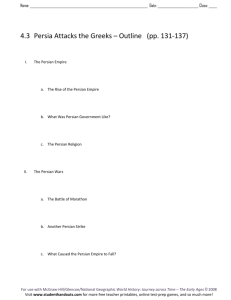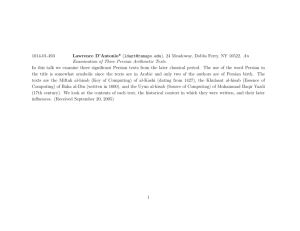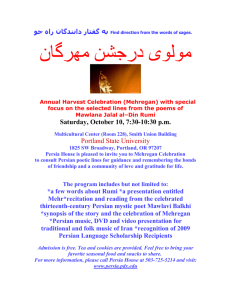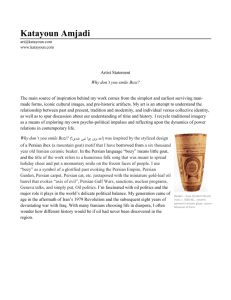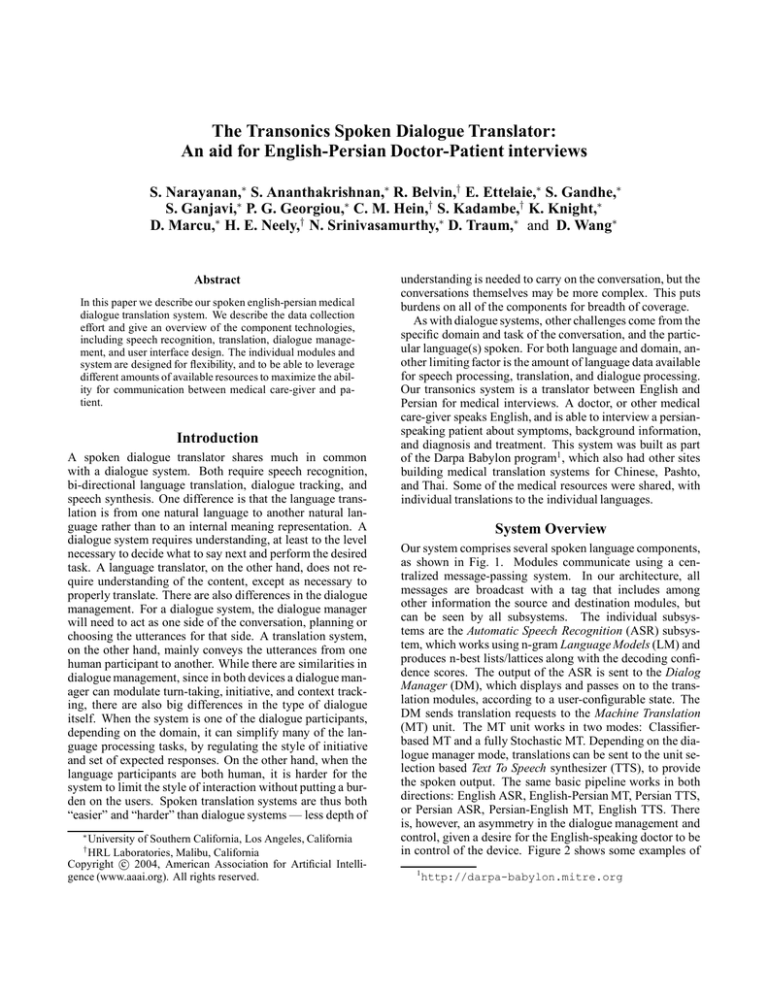
The Transonics Spoken Dialogue Translator:
An aid for English-Persian Doctor-Patient interviews
S. Narayanan,∗ S. Ananthakrishnan,∗ R. Belvin,† E. Ettelaie,∗ S. Gandhe,∗
S. Ganjavi,∗ P. G. Georgiou,∗ C. M. Hein,† S. Kadambe,† K. Knight,∗
D. Marcu,∗ H. E. Neely,† N. Srinivasamurthy,∗ D. Traum,∗ and D. Wang∗
Abstract
In this paper we describe our spoken english-persian medical
dialogue translation system. We describe the data collection
effort and give an overview of the component technologies,
including speech recognition, translation, dialogue management, and user interface design. The individual modules and
system are designed for flexibility, and to be able to leverage
different amounts of available resources to maximize the ability for communication between medical care-giver and patient.
Introduction
A spoken dialogue translator shares much in common
with a dialogue system. Both require speech recognition,
bi-directional language translation, dialogue tracking, and
speech synthesis. One difference is that the language translation is from one natural language to another natural language rather than to an internal meaning representation. A
dialogue system requires understanding, at least to the level
necessary to decide what to say next and perform the desired
task. A language translator, on the other hand, does not require understanding of the content, except as necessary to
properly translate. There are also differences in the dialogue
management. For a dialogue system, the dialogue manager
will need to act as one side of the conversation, planning or
choosing the utterances for that side. A translation system,
on the other hand, mainly conveys the utterances from one
human participant to another. While there are similarities in
dialogue management, since in both devices a dialogue manager can modulate turn-taking, initiative, and context tracking, there are also big differences in the type of dialogue
itself. When the system is one of the dialogue participants,
depending on the domain, it can simplify many of the language processing tasks, by regulating the style of initiative
and set of expected responses. On the other hand, when the
language participants are both human, it is harder for the
system to limit the style of interaction without putting a burden on the users. Spoken translation systems are thus both
“easier” and “harder” than dialogue systems — less depth of
∗
University of Southern California, Los Angeles, California
HRL Laboratories, Malibu, California
c 2004, American Association for Artificial IntelliCopyright gence (www.aaai.org). All rights reserved.
†
understanding is needed to carry on the conversation, but the
conversations themselves may be more complex. This puts
burdens on all of the components for breadth of coverage.
As with dialogue systems, other challenges come from the
specific domain and task of the conversation, and the particular language(s) spoken. For both language and domain, another limiting factor is the amount of language data available
for speech processing, translation, and dialogue processing.
Our transonics system is a translator between English and
Persian for medical interviews. A doctor, or other medical
care-giver speaks English, and is able to interview a persianspeaking patient about symptoms, background information,
and diagnosis and treatment. This system was built as part
of the Darpa Babylon program1 , which also had other sites
building medical translation systems for Chinese, Pashto,
and Thai. Some of the medical resources were shared, with
individual translations to the individual languages.
System Overview
Our system comprises several spoken language components,
as shown in Fig. 1. Modules communicate using a centralized message-passing system. In our architecture, all
messages are broadcast with a tag that includes among
other information the source and destination modules, but
can be seen by all subsystems. The individual subsystems are the Automatic Speech Recognition (ASR) subsystem, which works using n-gram Language Models (LM) and
produces n-best lists/lattices along with the decoding confidence scores. The output of the ASR is sent to the Dialog
Manager (DM), which displays and passes on to the translation modules, according to a user-configurable state. The
DM sends translation requests to the Machine Translation
(MT) unit. The MT unit works in two modes: Classifierbased MT and a fully Stochastic MT. Depending on the dialogue manager mode, translations can be sent to the unit selection based Text To Speech synthesizer (TTS), to provide
the spoken output. The same basic pipeline works in both
directions: English ASR, English-Persian MT, Persian TTS,
or Persian ASR, Persian-English MT, English TTS. There
is, however, an asymmetry in the dialogue management and
control, given a desire for the English-speaking doctor to be
in control of the device. Figure 2 shows some examples of
1
http://darpa-babylon.mitre.org
Figure 1: Block diagram of system. Note that the communication server allows interaction between all subsystems, and the
broadcast of messages. Our vision is that only the doctor will have access to the GUI, and the patient will only be given a
microphone headset.
the messages sent by the modules. The first tag shows who
the message is to and from, and the type of message. The
next field is an utterance ID number – shared by all messages pertaining to this utterance. After this is the content
field, which depends on the message type. The first message is from the speech recognizer to the dialogue manager,
showing the five best hypotheses with confidence scores for
an english utterance. The dialogue manager sends messages
to the GUI to update the display, and then sends the hypotheses one by one to the machine translation system, which returns the translation (in USCPers) with confidence, paired
with the class (and original input, if different).
Data Collection & Transcription
All of the major system modules rely on data-driven approaches. Since there was no ready-made source of largescale data, this required a major data-collection effort within
the project. Our approach to this problem was multipronged: leverage and adapt existing resources, and develop new resources. The ideal data set would be mediated/translated dialogues, of precisely the sort that the system would engage in. Next best would be dialogues mediated by human translators. The initiative and size, speed,
and complexity of the dialogues would be different, but there
would still be ready-made examples of speech and translations. Finally, mono-lingual Doctor-patient dialogues would
FADT 0260|YOU HAVE ANY QUESTIONS *0.079513|
DO YOU HAVE ANY QUESTIONS *0.079700|
HE YOU HAVE ANY QUESTIONS *0.080245|
YOU HAD ANY QUESTIONS *0.080305|
SEE YOU HAVE ANY QUESTIONS *0.080591
FDGC 0260|StatusBar*-1.0| Working on Translating
english to persian*1.0
FDMT 0260|YOU HAVE ANY QUESTIONS *0.079513
FMDT 0260|467>sWAl dygry ndAryd*0.00763885|
5467>DO YOU HAVE ANY QUESTIONS*0.00763885|
FDGT 0260|YOU HAVE ANY QUESTIONS *0.079513|
5467>DO YOU HAVE ANY QUESTIONS*0.00763885|
467>sWAl dygry ndAryd*0.00763885
FDMT 0260|DO YOU HAVE ANY QUESTIONS *0.0797
FMDT 0260|467>sWAl dygry ndAryd*0.00471005|
5467>DO YOU HAVE ANY QUESTIONS*0.00471005|
Figure 2: Examples of System messages
at least give domain coverage, and could be translated offline. Here the mediated nature is also missing. Other modules could also make use of other data sources, such as paraphrases of existing utterances, concept lists, translated material (in and out of domain), and spoken samples in Farsi and
English.
Table 1 provides a summary of the currently identified
data sources for the Transonics system development. It
Data Description
Size and original form
Used in
English
questions
and
answers (Marine Acoustics)
600 sentences in English and Persian - text
FSG,
CBMT
Paraphrasing above
2000 sentences - text and audio
CBMT
WoZ experiments
100+ utterances in audio format
All modules
Medical phrasebooks
600+ Q&A utterances. Translated and tran
All modules
Persian newspaper mining
Virtually unlimited text. Continuously converted to USCPers+
LM
DLI data
speech
About 5h of mediated doctor-patient interaction – audio
All modules
-
spontaneous
CECOM data - scripted
500 English with Persian translations - No transcription
CECOM data
spontaneous
semi-
75 Q&A pairs in both English and Persian - No transcription
semi-
Force protection data. About 350 short interactions.
IBM
data
spontaneous
-
USC Medical school
USC/HRL
collection
medical
Videotaped medical
examinations
data
interactions
–
standardized
LM, DM
patient
LM, DM
Doctor patient interaction, using trained patients and medical
students. 200 Dialogs in audio format.
LM, DM
Table 1: List of data sources and uses. (FSG -finite state grammar, LM - Language Model, CBMT - classifier based
machine translation, DM - dialog manager).
includes domain material gathered from existing resources
(and translated) or material being specifically collected as a
part of the project. The first 4 rows are target-domain material completely transcribed/translated in both English and
Persian. For the medical domain, the initial bootstrapping
was based on the availability of a large amount of common
medical expressions, obtained from Marine Acoustics Inc2
and a number of medical phrase books. These were not
only useful for the creation of fixed state grammars and the
Classifier based MT, but are also valuable in enriching our
medical domain vocabulary (especially the medical phrase
book data). In addition, for supporting development of language models for generic larger vocabulary recognition in
Persian, we have been gathering Persian text corpora from
mining publicly available newspapers. Due to the tremendous amount of data needs and processing involved, we are
continuing the collection and transcription process.
The other major focus of our data needs is spoken language interaction data in the target domains. Although we
identified some limited sources of existing spoken dialog interaction data (in English for e.g., doctor-patient dialogs),
these are significantly different from the mediated dialogs
of the Transonics system. Hence, a significant portion of
current efforts is focused on generating actual interaction
data (both monolingual and bilingual modes) in the target
domain. In addition to feeding the ASR and MT modules,
these data are valuable for designing the dialog interface.
2
http://www.sarich.com
USC Standardized Patient Data Collection
The most important data collection effort that has been undertaken by USC/HRL, and in collaboration with the USC
Keck School of Medicine, is the Standardized Patient data
collection. The practice of using Standardized Patients began in Los Angeles in the 1960s as a way of allowing medical students to gain experience interacting with and diagnosing patients, and with a greater degree of consistency
in terms of symptoms displayed; moreover, the patients are
trained to rate the students on their bedside manner, handling
of the physical examination, and methods of diagnosis.
Standardized Patient cases are created by MD’s and RNs,
ideally ones who have had first-hand experience with such
medical instances. The cases consist of a detailed description of the symptoms the standardized patient is to report
(some brief samples are shown below), as well as a onepage synopsis of some of the patient’s vital signs, which
will differ from their actual vital signs, but which will serve
as important indicators to the students in forming a proper
diagnosis (see Fig. 3). The SP goes through extensive training and two practice run examinations by qualified MD’s.
Notice that the instructions are very specific, but do not tell
the patient exactly how to report the symptoms. This is important for the dialog data collection, as we are interested
in collecting variations on the way that particular symptoms
are reported.
The cases, which include among others, tuberculosis
(TB), malaria, flu, heart attack, severe diarrhea, etc., were
chosen not only to get better balance of illnesses to injuries –
the vast majority of the IBM data collection are injuries – but
also after research into published material by military insti-
(A) Brief patient instructions:
The cough started about 3 months ago. It is constant and produces sputum that
is usually thick and yellow and occasionally has some flecks of blood in it. The
sputum does not have any bad smell. The cough is deep and you have occasional
coughing “fits.” The cough is fairly constant, happening often during both the day
and the night. You have also lost weight during this time without dieting. You have
noticed your skirt/pants have become very loose.
(B) Doctors chart of vital signs:
Temperature:
Pulse:
Respiration:
Blood Pressure:
99 degrees F
100
18
112/80 mm Hg
Figure 3: (A) Only seen by patient. (B) Seen by both medical student and patient
tutions (such as the Naval Medical Research Institute, Army
sources, Army Research Inst. of Environmental Medicine,
etc.).
Transcription Methods
Data transcription in Persian is a harder task than in many
languages. First, Persian is traditionally represented in Arabic script, with stylizations of some characters depending
on the position of the character within the word. One issue
is that there is no accepted standard for computer encoding
of the characters, with different codings used for different
archives of existing text. Thus, first one must choose a character set to represent the Arabic script that allows easy access to non-Persian speakers, avoids the multiple character
forms, and reduces the transcription overhead. Our choice
has been the creation of the USCPers ascii-based transcription scheme. Additionally, we need to provide pronunciations of each word (for ASR & TTS), and we have created the USCPron transcription system to address this issue.
Furthermore, the Persian written system does not include the
vowel sounds in its written form, and thus multiple transcriptions on USCPers or the original Arabic script can result in
both different pronunciations and different meanings. This
prompts the need for a different transcription scheme that
enables a one-to-one mapping between the acoustic representation (excluding user variability) and the transcription
method, which we introduce as USCPers+. An in-depth
analysis of our transcription schemes is given in (Ganjavi,
Georgiou, & Narayanan 2003).
System Components
In this section we briefly describe the major components of
the system. Each of them is tuned for translated medical
dialogues, using a variety of techniques and data sources.
Speech Recognition
To recognize speech utterances we employ separate English
and Persian Speech recognizers, built using Sonic (Pellom
2001), with local models and training data. For English, we
are able to take advantage of existing large language models,
such as the wall street journal corpus. In Persian, however,
there is a lack of adequate existing speech data. To overcome
this drawback we adopted a data driven language-adaptive
technique. We borrowed acoustic data from English to compensate for the lack of data in Persian. The key requirement
in enabling the use of English data for Persian ASR is the development of a phoneme mapping between the two. We used
a novel Earth Movers Distance based sub-phonetic/phonetic
mapping (Srinivasamurthy & Narayanan 2003). Additionally, for adaptation/re-training, the Marine Acoustics data
was translated into Persian and read by 18 native Persian
speakers (9 females and 7 males). We compared Persian
adapted/re-trained ASRs using seed models from (i) sparse
Persian speech data (FARSDAT), (ii) knowledge based English phonemes, (iii) data driven phonetic models and (iv)
data driven sub-phonetic models as shown on Table 2. The
results we obtained are very encouraging, illustrating that it
is possible to make use of acoustic data even between diverse languages like English and Persian to improve the performance of ASRs in languages constrained by sparse data.
We also observe that our proposed technique while having
better performance when the re-training is used does not
perform as well when only adaptation is used. A possible
reason for this is that the adaptation scheme used, MLLR, is
restricted to only linear transformations, which may not be
sufficient to model differences in phonemes between different languages, where phoneme contexts play an important
role.
Seed Models
FARSDAT
Knowledge based
Phonetic mapping
Sub-phonetic mapping
Phoneme Error Rate
Re-training Adaptation
20.35%
38.95%
20.00%
39.87%
20.13%
57.03%
19.80%
51.48%
Table 2: Phoneme error rates obtained for different
approaches. Observe that sub-phonetic mapping ASR
achieved the best recognition performance when re-training
was used.
To develop a full LM based ASR for Persian, we have successfully mined data from Persian news sources. Conversion
to USCPers can be automated to a large degree. The data are
subsequently processed by our team of transliterators to create the USCPers+ script of the same text, while at the same
time minor modifications may be made to reflect predefined
classes. The LM generated from this data as well as our
existing English language LM will be interpolated with the
ones we expect to create from the limited amount of medical
data available, such as the standardized patient examination
data and the USC/HRL collection effort.
Machine Translation
The approach we employ for the Machine Translation unit
is twofold. A classifier is applied as the main translator unit
of the system because of its faster and more accurate performance, while a statistical machine translator (SMT) is kept
as the backup unit for the cases when the classifier response
is not within an acceptable confidence margin. These cases
should be relatively infrequent if significantly large number
of classes are chosen for the classifier based MT.
As a first step in building a classifier, the proper set of
standard questions and answers that covered the context was
selected. Every standard question or answer was chosen as
a representation of a class.
Following each input utterance, the system is expected to
classify it in one of the predefined classes and generate the
pre-stored translation. This requires training data to create
the classes that are represented by each standard question or
answer. To collect this data we created an online tool where
a sentence was presented and users were asked to paraphrase
it, thus expanding the coverage area of our training corpus.
In addition, and in order to model expected errors introduced
from the ASR module, we collected acoustic paraphrasing
data that were not cleaned (i.e., the recognized transcript
may not match the uttered speech).
The resulting dataset was used to train a naive Bayesian
classifier with uniform prior probabilities. The test set was
gathered from an ASR and consists of both standard questions and paraphrased data. Since the test phase paraphrasing is separate and additional to the training set paraphrasing, there is significant test phrases that are new for the system.
From the collected data we have established a monotonically increasing performance in the MT classification as the
paraphrasing increases. With the available paraphrasing the
performance is roughly linearly increasing with over 1-2%
per paraphrase round. We are continuously collecting more
data to improve our classification quality, and additionally
we are introducing more original phrases to increase our domain coverage.
A more sophisticated classification scheme that consists
of a lattice of finite state transducers has been under development. A group of FST’s model each main block in the
real system. Thus, the ASR is modeled by a phoneme corrupter FST followed by a phoneme-to-word transducer. A
set of unigram based FST’s associated with each class followed by a bigram filter and a word-to-phoneme FST forms
the speaker model. For every utterance from the (real) ASR
a detection procedure, e.g., Viterbi algorithm is performed
to get the corresponding class. Early experiments with this
system show 3.4% increase over the accuracy of the naive
Bayesian classifier. Better ways of using the training data to
build these FST’s are under investigation.
The second method, to be used in the case of poor classification confidence, is the Stochastic MT method. SMT
is based on word-to-word translation and can generate the
translation for every input sentence. However, accuracy of
the SMT, although a function of the training corpus, is in
general expected to be lower than the accuracy of the classifier. The best performance for SMT can be achieved by
employing a large amount of bilingual parallel text for training. This training corpus can be used to build a language
model for the target language along with a statistical translation table, which relates words in the source language and
their counterparts in the target language. However, due to
the lack of any significant amount of English-Persian parallel text, we are following the approach of using the initial
and target language models, and combining these with a dictionary approach for transition between the two languages.
The LMs used are the same as has already been discussed in
the ASR section.
Finally, another consideration in favor of the classifier
system is the high computational demands of the SMT algorithms. In a speech to speech system where latency is
crucial, the SMT system would always be kept as a backup
choice after the utilization of the faster classifier system.
Text to Speech
We rely on a hybrid unit selection based speech synthesis. In
the default case, when the output is chosen from a classifierbased MT, the generated phrases are known a priori. Hence,
our first system release enabled us to use a prompt based system for spoken output. The other end of the unit selection
possibility is through diphone concatenation. We have implemented such a synthesizer based on Festival3 for English
and Persian. Note that there are 29 sounds in the Persian
language (6 vowels & 23 consonants), which results in the
theoretical number of 900 diphones, fewer than needed for
English that has a larger vowel inventory.
Dialogue Manager and User Interface
The dialogue manager component is closely bundled with
the user interface and has the main task of using the other
components to promote effective communication between
the participants. The dialogue manager performs the following tasks:
• presents the medical care-giver with options for style of
dialogue flow
• presents the care-giver with a visualization of the dialogue, speech recognition, and translation processes
• depending on the user-settable configuration and user
choices, calls other modules for processing
• keep track of the discourse history
• provide hypotheses of most likely next utterances
• manage the turn-taking and grounding interaction between speakers
We have chosen an asymmetric dialogue flow, assuming
that the medical care-giver will maintain the initiative in the
dialogue, will have sole access to the controls and display of
the translation device, and will operate the push-to-talk controls for both him or herself and the persian patient. There
are several reasons for this choice, ranging from the predominance of Doctor initiative to the practicalities of knowledge
of how to operate the device, keeping possession, as well
as limitations of current technology such that push-to-talk
recognition is currently more reliable than “always listening” systems.
Figure 4 shows the initial screen in choice mode. The
medical care-giver can choose to click on the left green button to speak in English, or on the right to have the patient
speak in Persian. Also, there are three smaller buttons in
between, which will play recorded Persian requests for the
3
http://www.cstr.ed.ac.uk/projects/festival
Figure 4: Transonics Interface Ready for Speech
patient to repeat, rephrase, or wait for the beep before speaking. While the speech recognizers are active, the audio-level
meter shows sound signal, and listening buttons turn green.
As the speech recognition module is producing recognition
hypotheses, the current best hypothesis is shown and updated in the “ASR recognized” box. When speech recognition is finished, the top five results are sent to the machine
translation system. In choice mode, for English to Persian
these are presented in two sections, as in Figure 5, headed
“I can try to translate these” (results from the SMT, which
may or may not end up in fluent persian), and “I can definitely translate these” (results from the classifier, which will
be fluent, but might not be close enough to what the English
speaker said). The care-giver can click any of these buttons
to translate the selection to Persian, or can choose “none of
the above”, and try to speak again (either another attempt at
the same thing, or changing the input). For Farsi recognition, the same process is used, except that the first choice is
always said, while all translations are available to the caregiver for inspection. The care-giver can choose a response
from the set presented (for updating the dialogue history), if
there is one that is sufficiently clear and relevant, or can ask
the Persian speaker to confirm (or can try to ask a follow-up
question).
Figure 5: Choice mode
Figure 6 shows the configuration screen, giving an advanced user additional options for system performance
modes. In the left corner, there is the choice of basic modes.
In addition to “choice mode”, described above, there is “automatic mode”, in which the first choice translation is played
without need for gui intervention. Confirmation mode is
between the two, where only the top choice is presented,
but the user must still select whether to speak the translation or try again. In the upper right corner are confidence
thresholds for whether the translations are good enough to
proceed. The top translation with confidence higher than
the upper threshold (english only) will be translated without need for confirmation. Any hypotheses below the lower
threshold will be pruned and not even presented to the user.
The translations in between the thresholds will be presented
for user choice and confirmation.
Figure 6: Configuration Screen
The bottom part of Figure 6 shows the dialogue manager’s
calculation of the current medical case and phase within
the examination. The phases include introduction, registration, Q&A, Physical examination, Diagnosis, and Treatment Plan. The dialogue manager’s current estimation of
the probability distribution for the phases is shown here (the
classifier was built using the MALLET toolkit (McCallum
2002). In this example, Q&A is the most likely possibility, though registration is still somewhat likely. Probability
estimates are based on the correspondence between phases
and translation classes, as calculated from hand-labelled collected dialogues. There are also click buttons so that the
user can inform the system of the current case and phase
when that is known (in this case, the probability becomes
close to 100% for the next utterance). Just above the phase
estimation is a set of predictions of most likely next utterances for the care-giver, based on the estimation of case and
phase. The user can select one of these to translate rather
than speaking his own utterance, if desired.
Finally, the dialogue manager keeps a history of the accepted utterances in the dialogue (English utterances that
were translated to Persian, and Persian replies accepted by
the care-giver), as shown in Figure 7. The care-giver utterances are shown in white, and the patient replies shown in
Figure 7: Dialogue History view
brown. This can be a useful memory aid for the doctor, and
can also be used to go back and revisit any vague or troublesome points. Clicking on one of the utterances will cause
the system to replay the associated translations.
Evaluation
As part of the Darpa Babylon program, our transonic system
has been evaluated for basic usability by MITRE. The evaluation involved MITRE-recruited English speaking government Doctors and Nurses, and Farsi speakers acting as patients (with training similar to that for the standardized patient program). While the formal analysis of the results are
not yet available, informal observation of the process shows
that the participants can sometimes communicate quite effectively using the device. On the other hand, some interactions were less successful at reaching a correct diagnosis
and treatment plan. The translation protocol may be difficult to learn, especially for older patients. More work is
still required to determine how much the system-mediated
interviews degrade from mono-lingual interaction, and how
much they add in a situation where no other translation assistance is available.
Acknowledgments
This work was supported by the DARPA Babylon program,
contract N66001-02-C-6023.
References
Ganjavi, S.; Georgiou, P. G.; and Narayanan, S. 2003.
Ascii based transcription schemes for languages with the
arabic script: The case of persian. In ASRU.
McCallum, A. K. 2002. Mallet: A machine learning for
language toolkit. http://mallet.cs.umass.edu.
Pellom, B. 2001. Sonic: The university of colorado continuous speech recognizer. Technical Report TR-CSLR-200101, University of Colorado.
Srinivasamurthy, N., and Narayanan, S. 2003. Languageadaptive persian speech recognition. In Eurospeech.


